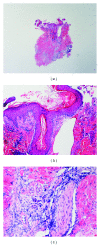A Rare Case of Kikuchi Fujimoto's Disease with Subsequent Development of Systemic Lupus Erythematosus
- PMID: 23346446
- PMCID: PMC3546453
- DOI: 10.1155/2012/325062
A Rare Case of Kikuchi Fujimoto's Disease with Subsequent Development of Systemic Lupus Erythematosus
Abstract
Kikuchi Fujimoto's disease (KFD) is a rare, immune-mediated, self-limiting disorder with unique histopathological features. KFD is usually seen in young Asian females; however, cases have been reported throughout the world and in all ethnicities. It has been recognized that there is a rare association between Systemic Lupus Erythematosus (SLE) and KFD via sporadic case reports. The exact pathophysiological relationship between these two diseases is still unclear. We report a case of a young Asian female who presented with persistent fever and lymphadenopathy and was diagnosed with Kikuchi Fujimoto's disease based on lymph node biopsy; although an SLE workup was done, she did not meet the American Rheumatology Association (ARA) diagnostic criteria for lupus, and the lymph node biopsy did not show features of SLE. She improved clinically with a short course of steroid therapy. Two months later, the patient presented with central facial rash and arthralgia. SLE workup was repeated, a skin biopsy was done, and the results at this time supported a diagnosis of SLE.
Figures




Similar articles
-
Histiocytic necrotizing lymphadenitis, Kikuchi-Fujimoto's disease, associated with systemic lupus erythemotosus.QJM. 1997 Aug;90(8):531-3. doi: 10.1093/qjmed/90.8.531. QJM. 1997. PMID: 9327032 Review.
-
Kikuchi-Fujimoto's disease associated with systemic lupus erythematous: difficult case report and literature review.Lupus. 2014 Aug;23(9):939-44. doi: 10.1177/0961203314530794. Epub 2014 Apr 16. Lupus. 2014. PMID: 24739458 Review.
-
Histiocytic necrotizing lymphadenitis (Kikuchi-Fujimoto's disease) mimicking systemic lupus erythematosus: a review of two cases.Lupus. 2006;15(6):384-7. doi: 10.1191/0961203306lu2320cr. Lupus. 2006. PMID: 16830886
-
Autoimmune hepatitis associated with Kikuchi-Fujimoto's disease.Eur J Gastroenterol Hepatol. 2008 Jan;20(1):79-82. doi: 10.1097/MEG.0b013e32825a6a9e. Eur J Gastroenterol Hepatol. 2008. PMID: 18090996
-
Kikuchi-Fujimoto's disease, histiocytic necrotizing lymphadenitis, mimicking systemic lupus erythematosus.J Med Assoc Thai. 2002 Sep;85(9):1037-41. J Med Assoc Thai. 2002. PMID: 12450085
Cited by
-
Kikuchi-Fujimoto Disease: Report of a Case with Progression to Lupus Nephritis.Am J Case Rep. 2021 Mar 7;22:e927351. doi: 10.12659/AJCR.927351. Am J Case Rep. 2021. PMID: 33677464 Free PMC article.
-
Fatal Kikuchi-like lymphadenitis associated with connective tissue disease: a report of two cases and review of the literature.Springerplus. 2015 Apr 8;4:167. doi: 10.1186/s40064-015-0925-7. eCollection 2015. Springerplus. 2015. PMID: 25897412 Free PMC article.
-
Kikuchi-Fujimoto disease and systemic lupus erythematosus.Int Med Case Rep J. 2016 Jun 29;9:163-7. doi: 10.2147/IMCRJ.S106396. eCollection 2016. Int Med Case Rep J. 2016. PMID: 27418858 Free PMC article.
-
Systemic Lupus Erythematosus Lymphadenopathy Presenting as Kikuchi-Fujimoto Disease in an Adolescent.Cureus. 2023 Feb 22;15(2):e35304. doi: 10.7759/cureus.35304. eCollection 2023 Feb. Cureus. 2023. PMID: 36968890 Free PMC article.
-
Kikuchi-Fujimoto Disease With Systemic Lupus Erythematosus and Systemic Sclerosis Overlap: A Unique Clinical Presentation.Cureus. 2023 Sep 10;15(9):e44986. doi: 10.7759/cureus.44986. eCollection 2023 Sep. Cureus. 2023. PMID: 37822435 Free PMC article.
References
-
- Kikuchi M. Lymphadenitis showing focal reticulum cell hyperplasia with nuclear debris and phagocytes. Acta haematologica Japonica. 1972;35:379–380.
-
- Fujimoto Y, Kojima Y, Yamaguchi K. Cervical Subacute necrotizing lymphadenitits. Naika. 1972;20:920–927.
-
- Kucukardali Y, Solmazgul E, Kunter E, Oncul O, Yildirim S, Kaplan M. Kikuchi-fujimoto disease: analysis of 244 cases. Clinical Rheumatology. 2007;26(1):50–54. - PubMed
-
- Hrycek A, Cieślik P, Szkróbka W, Pajak J. Kikuchi-Fujimoto disease: a case report. RRheumatology International. 2005;26(2):179–181. - PubMed
-
- Bailey EM, Klein NC, Cunha BA. Kikuchi's disease with liver dysfunction presenting as fever of unknown origin. The Lancet. 1989;2(8669):p. 986. - PubMed
LinkOut - more resources
Full Text Sources

